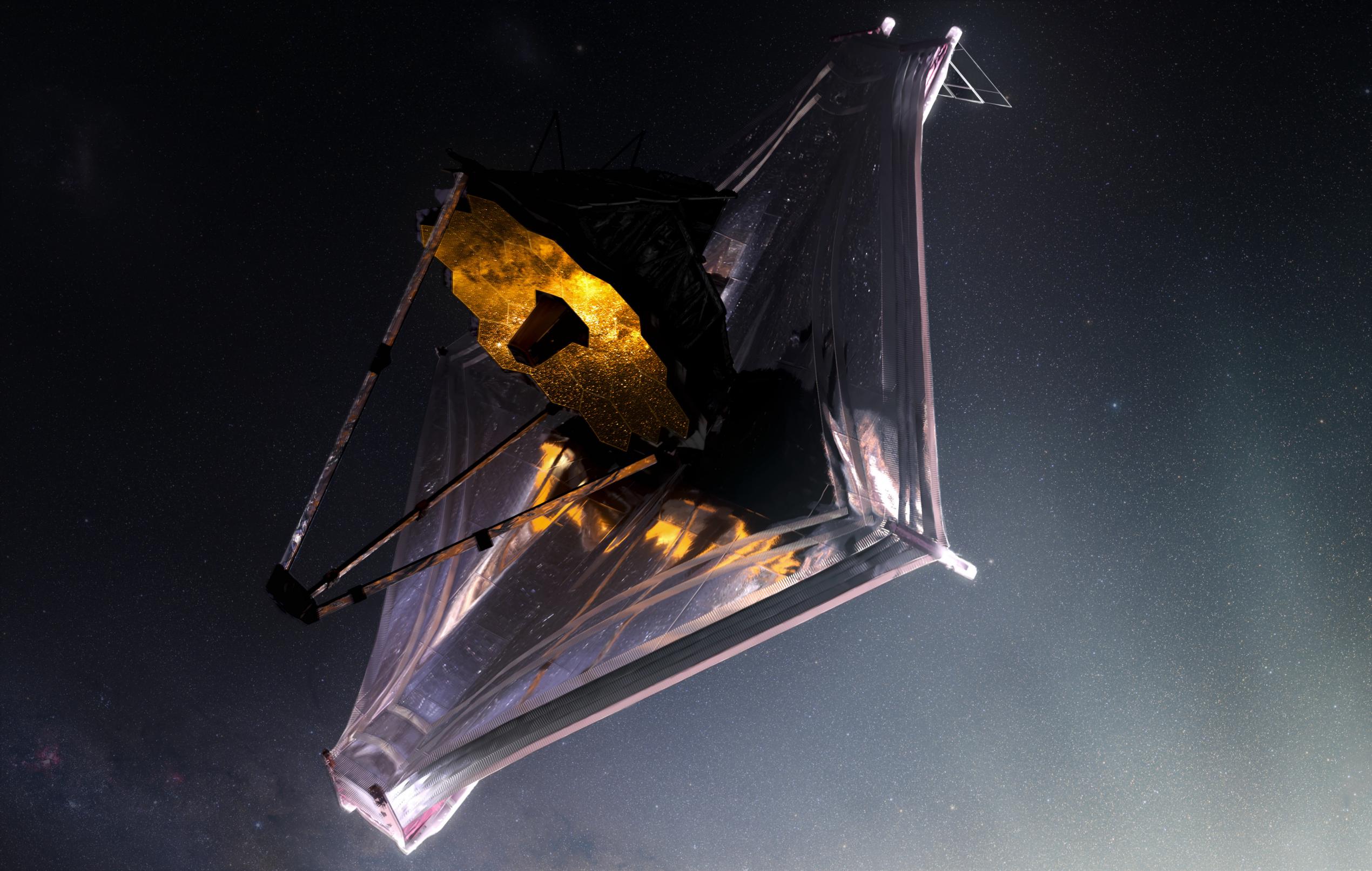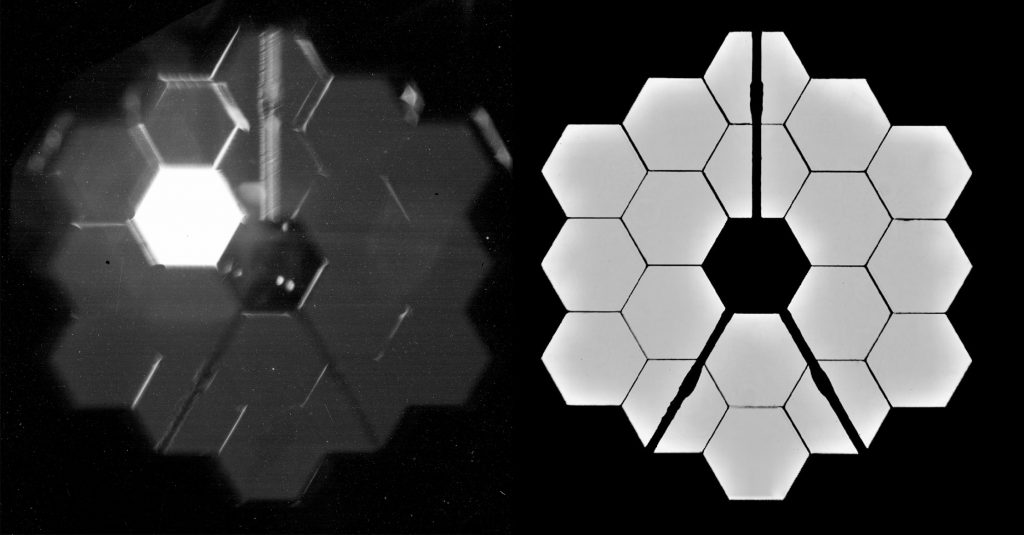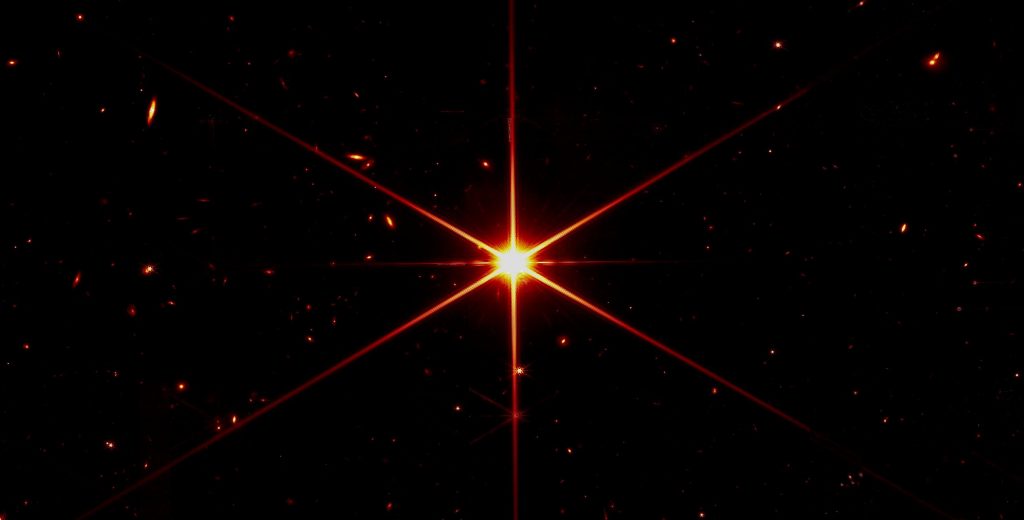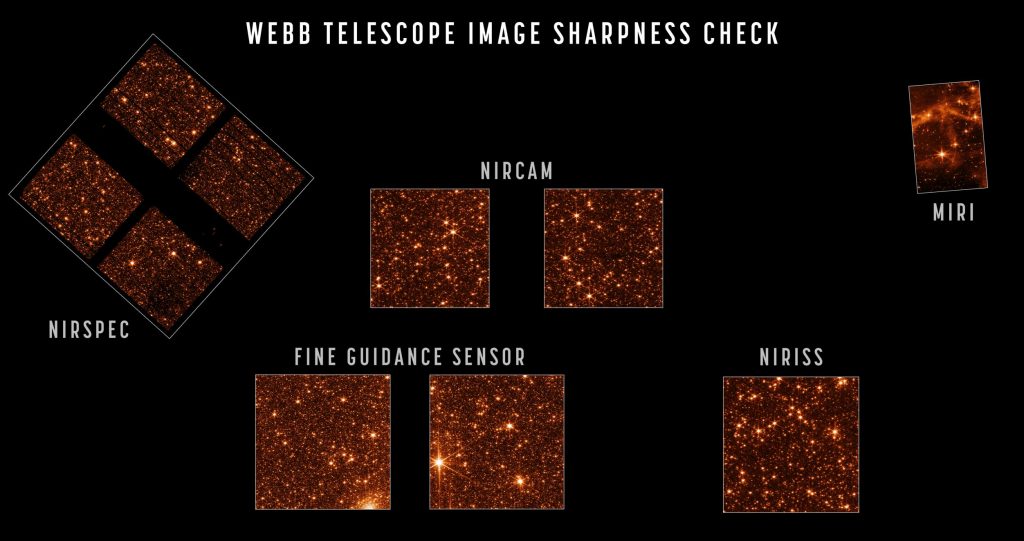

News
NASA’s Webb Telescope mirror crushes “most optimistic predictions” after final alignment
NASA says that the nascent James Webb Space Telescope’s (JWST) “optical performance…continues to be better than the…most optimistic predictions” after completing the alignment of its record-breaking mirror.
Between 7 and 14 years behind schedule and over budget by a factor of 2 to 10, an Arianespace Ariane 5 rocket sent the Webb Telescope on its way to deep space on December 25th, 2021. Weighing 6.2 tons (~13,600 lb), JWST was almost half as heavy at liftoff as NASA’s iconic Hubble Space Telescope despite packing an unprecedented origami-like mirror with more than six times Hubble’s total collecting area. The combination of extreme mass reduction and extraordinary complexity required to launch such a large mirror so far from Earth with a rocket like Ariane 5 helps to partially explain why the Webb Telescope took so long (~18 years) and cost so much (~$9.7 billion) to design, develop, and build.
Nonetheless, launch it finally did. Ariane 5 did most of the work, sending the telescope on a trajectory that – with some help from its onboard thrusters – would guide it to the Sun-Earth L2 Lagrange point located some 1.5 million kilometers (~950,000 miles) from Earth. In perhaps the largest relief in the history of space-based observatories, the Webb Telescope’s immensely complex deployment process was then completed without a single major issue. 30 days after liftoff, the telescope – fully deployed – reached its operational orbit.
For the past four months, in comparison, almost all JWST work has focused on the less visible and far smaller processes of alignment and calibration. Each of JWST’s 18 main mirror segments has slowly but surely inched micrometer by micrometer into position while large swaths of the telescope slowly cooled to ambient temperatures – essential for maximum performance. Simultaneously, all of Webb’s primary instruments have achieved first light and entered the early phases of calibration and commissioning. Only after the instruments are painstakingly calibrated, the mirror is perfectly aligned, and crucial hardware is chilled to temperatures as low as -449°F (-267°C) can Webb begin to observe the universe and revolutionize large subsets of space science.

The first and most important step – mirror alignment – is now complete. The alignment process began in February 2022, six weeks after liftoff. First, images were captured with the unaligned mirror to help determine exactly what condition it was in. One by one, each of Webb’s 18 mirror segments were individually moved to determine which image each mirror was responsible for, which then allowed ground controllers to properly focus each mirror’s view of a target star. In a process known as “coarse phasing,” once those 18 points of light well-resolved and linked to a specific mirror segment, the segments were gradually steered on top of each other to produce a single image.
“Coarse” heavily undersells the almost unfathomable precision required to complete the step. To reach its full potential, each of the Webb Telescope’s mirror segments must be aligned to within 50 nanometers of each other. According to NASA, “if the Webb primary mirror were the size of the United States, each segment would be the size of Texas, and the team would need to line the height of those Texas-sized segments up with each other to an accuracy of about 1.5 inches.”

Fine phasing followed, involving an even more esoteric set of processes designed to focus the mirror as perfectly as possible. The resulting image was then tweaked to properly align it over the field of view of each of the Webb Telescope’s four main scientific instruments. Finally, some steps of the seven-step alignment process were redone or refined to fully optimize the mirror to the liking of its Earthbound creators and prospective users.
Ultimately, Webb Telescope alignment was extraordinarily successful, producing an image sharper and cleaner than even the “most optimistic predictions” made by its engineers. NASA says that the image is so detailed that it has effectively reached the physical resolution limit for a mirror the size of the Webb Telescope’s, meaning that it would have to violate the known laws of physics to resolve any more detail.

With mirror alignment complete, JWST has just one main hurdle left before science operations can begin: instrument commissioning. Commissioning is a catch-all phrase that covers a wide range of calibration, analysis, experiments, and optimization required to verify that JWST’s four main instruments are behaving as expected and accomplishing the work they were designed to do as accurately and reliably as possible.
At some point, the use of extraordinarily complex scientific instruments becomes more akin to an art form, and some degree of trust must be built up between scientists and their hopeful tools of the trade before they can confidently set chisel to marble and begin delving into the universe at unprecedented breadth and detail. If commissioning proceeds as smoothly as deployment and alignment, the JWST team could be ready to capture and share the telescope’s first actionable observations of the cosmos as early as July 2022.
Elon Musk
Tesla reveals it is using AI to make factories more sustainable: here’s how
Tesla is using AI in its Gigafactory Nevada factory to improve HVAC efficiency.

Tesla has revealed in its Extended Impact Report for 2024 that it is using Artificial Intelligence (AI) to enable its factories to be more sustainable. One example it used was its achievement of managing “the majority of the HVAC infrastructure at Gigafactory Nevada is now AI-controlled” last year.
In a commitment to becoming more efficient and making its production as eco-friendly as possible, Tesla has been working for years to find solutions to reduce energy consumption in its factories.
For example, in 2023, Tesla implemented optimization controls in the plastics and paint shops located at Gigafactory Texas, which increased the efficiency of natural gas consumption. Tesla plans to phase out natural gas use across its factories eventually, but for now, it prioritizes work to reduce emissions from that energy source specifically.
It also uses Hygrometric Control Logic for Air Handling Units at Giafactory Berlin, resulting in 17,000 MWh in energy savings each year. At Gigafactory Nevada, Tesla saves 9.5 GWh of energy through the use of N-Methylpyrrolidone refineries when extracting critical raw material.
Perhaps the most interesting way Tesla is conserving energy is through the use of AI at Gigafactory Nevada, as it describes its use of AI to reduce energy demand:
“In 2023, AI Control for HVAC was expanded from Nevada and Texas to now include our Berlin-Brandenburg and Fremont factories. AI Control policy enables HVAC systems within each factory to work together to process sensor data, model factory dynamics, and apply control actions that safely minimize the energy required to support production. In 2024, this system achieved two milestones: the majority of HVAC infrastructure at Gigafactory Nevada is now AI-controlled, reducing fan and thermal energy demand; and the AI algorithm was extended to manage entire chiller plants, creating a closed-loop control system that optimizes both chilled water consumption and the energy required for its generation, all while maintaining factory conditions.”
Tesla utilizes AI Control “primarily on systems that heat or cool critical factory production spaces and equipment.” AI Control communicates with the preexisting standard control logic of each system, and any issues can be resolved by quickly reverting back to standard control. There were none in 2024.
Tesla says that it is utilizing AI to drive impact at its factories, and it has proven to be a valuable tool in reducing energy consumption at one of its facilities.
Elon Musk
Tesla analysts believe Musk and Trump feud will pass
Tesla CEO Elon Musk and U.S. President Donald Trump’s feud shall pass, several bulls say.

Tesla analysts are breaking down the current feud between CEO Elon Musk and U.S. President Donald Trump, as the two continue to disagree on the “Big Beautiful Bill” and its impact on the country’s national debt.
Musk, who headed the Department of Government Efficiency (DOGE) under the Trump Administration, left his post in May. Soon thereafter, he and President Trump entered a very public and verbal disagreement, where things turned sour. They reconciled to an extent, and things seemed to be in the past.
However, the second disagreement between the two started on Monday, as Musk continued to push back on the “Big Beautiful Bill” that the Trump administration is attempting to sign into law. It would, by Musk’s estimation, increase spending and reverse the work DOGE did to trim the deficit.
Every member of Congress who campaigned on reducing government spending and then immediately voted for the biggest debt increase in history should hang their head in shame!
And they will lose their primary next year if it is the last thing I do on this Earth.
— Elon Musk (@elonmusk) June 30, 2025
President Trump has hinted that DOGE could be “the monster” that “eats Elon,” threatening to end the subsidies that SpaceX and Tesla receive. Musk has not been opposed to ending government subsidies for companies, including his own, as long as they are all abolished.
How Tesla could benefit from the ‘Big Beautiful Bill’ that axes EV subsidies
Despite this contentious back-and-forth between the two, analysts are sharing their opinions now, and a few of the more bullish Tesla observers are convinced that this feud will pass, Trump and Musk will resolve their differences as they have before, and things will return to normal.
ARK Invest’s Cathie Wood said this morning that the feud between Musk and Trump is another example of “this too shall pass:”
BREAKING: CATHIE WOOD SAYS — ELON AND TRUMP FEUD “WILL PASS” 👀 $TSLA
She remains bullish ! pic.twitter.com/w5rW2gfCkx
— TheSonOfWalkley (@TheSonOfWalkley) July 1, 2025
Additionally, Wedbush’s Dan Ives, in a note to investors this morning, said that the situation “will settle:”
“We believe this situation will settle and at the end of the day Musk needs Trump and Trump needs Musk given the AI Arms Race going on between the US and China. The jabs between Musk and Trump will continue as the Budget rolls through Congress but Tesla investors want Musk to focus on driving Tesla and stop this political angle…which has turned into a life of its own in a roller coaster ride since the November elections.”
Tesla shares are down about 5 percent at 3:10 p.m. on the East Coast.
Elon Musk
Tesla scrambles after Musk sidekick exit, CEO takes over sales
Tesla CEO Elon Musk is reportedly overseeing sales in North America and Europe, Bloomberg reports.

Tesla scrambled its executives around following the exit of CEO Elon Musk’s sidekick last week, Omead Afshar. Afshar was relieved of his duties as Head of Sales for both North America and Europe.
Bloomberg is reporting that Musk is now overseeing both regions for sales, according to sources familiar with the matter. Afshar left the company last week, likely due to slow sales in both markets, ending a seven-year term with the electric automaker.
Tesla’s Omead Afshar, known as Elon Musk’s right-hand man, leaves company: reports
Afshar was promoted to the role late last year as Musk was becoming more involved in the road to the White House with President Donald Trump.
Afshar, whose LinkedIn account stated he was working within the “Office of the CEO,” was known as Musk’s right-hand man for years.
Additionally, Tom Zhu, currently the Senior Vice President of Automotive at Tesla, will oversee sales in Asia, according to the report.
It is a scramble by Tesla to get the company’s proven executives over the pain points the automaker has found halfway through the year. Sales are looking to be close to the 1.8 million vehicles the company delivered in both of the past two years.
Tesla is pivoting to pay more attention to the struggling automotive sales that it has felt over the past six months. Although it is still performing well and is the best-selling EV maker by a long way, it is struggling to find growth despite redesigning its vehicles and launching new tech and improvements within them.
The company is also looking to focus more on its deployment of autonomous tech, especially as it recently launched its Robotaxi platform in Austin just over a week ago.
However, while this is the long-term catalyst for Tesla, sales still need some work, and it appears the company’s strategy is to put its biggest guns on its biggest problems.
-

 Elon Musk1 day ago
Elon Musk1 day agoTesla investors will be shocked by Jim Cramer’s latest assessment
-

 News6 days ago
News6 days agoTesla Robotaxi’s biggest challenge seems to be this one thing
-

 News2 weeks ago
News2 weeks agoTesla’s Grok integration will be more realistic with this cool feature
-

 Elon Musk2 weeks ago
Elon Musk2 weeks agoElon Musk slams Bloomberg’s shocking xAI cash burn claims
-

 News2 weeks ago
News2 weeks agoTesla China roars back with highest vehicle registrations this Q2 so far
-

 News2 weeks ago
News2 weeks agoTexas lawmakers urge Tesla to delay Austin robotaxi launch to September
-

 News2 weeks ago
News2 weeks agoTesla dominates Cars.com’s Made in America Index with clean sweep
-

 Elon Musk1 week ago
Elon Musk1 week agoFirst Look at Tesla’s Robotaxi App: features, design, and more




















